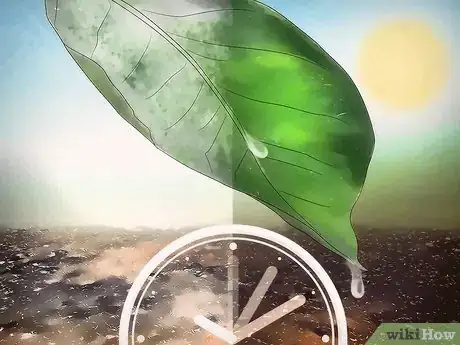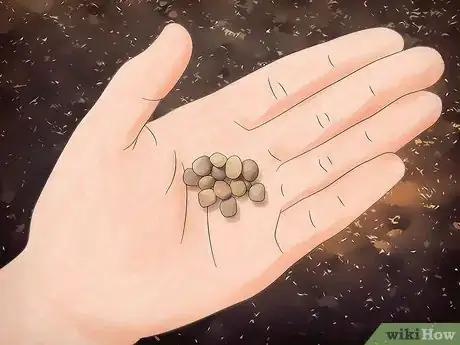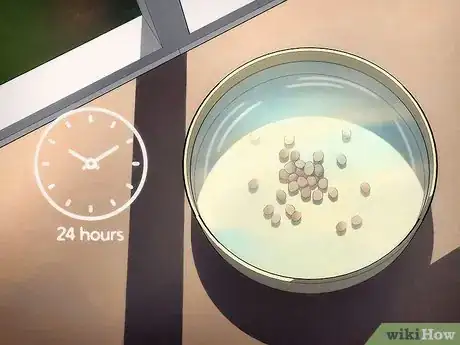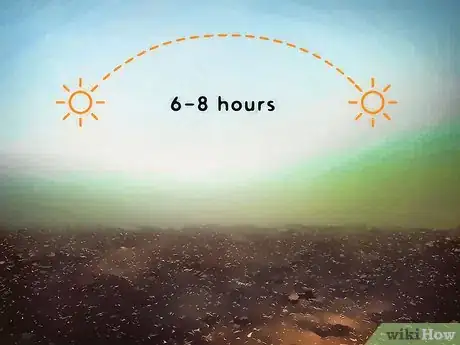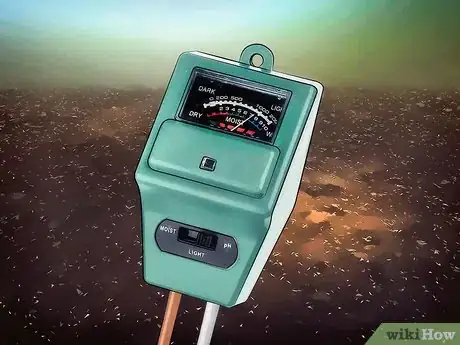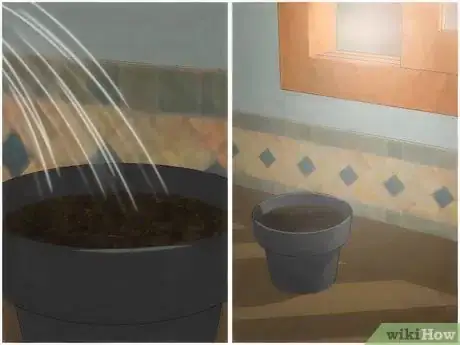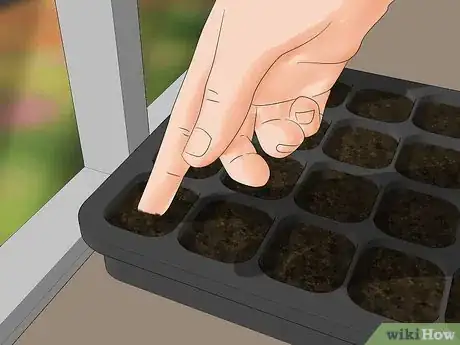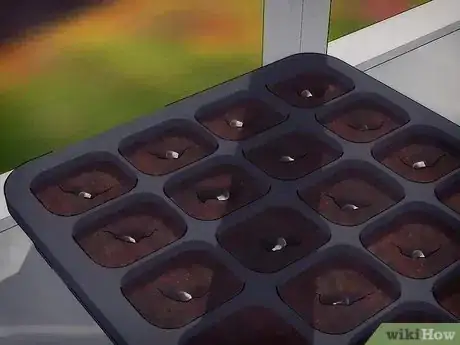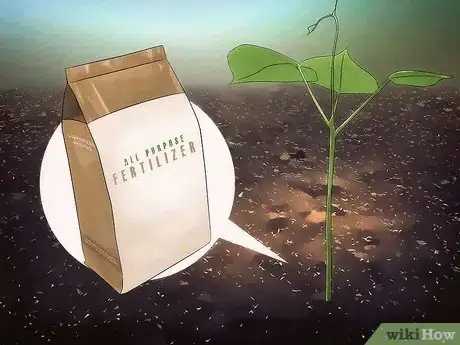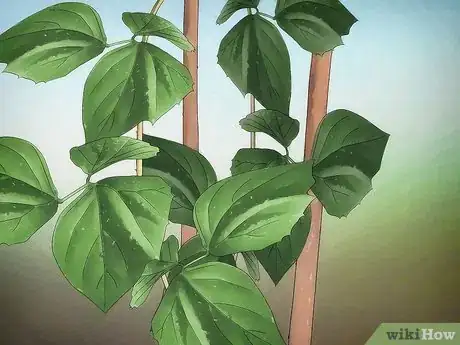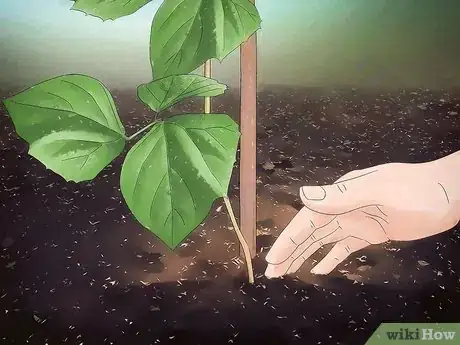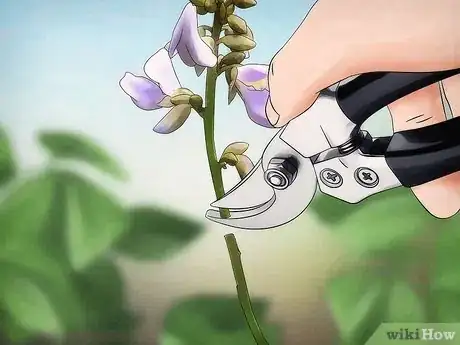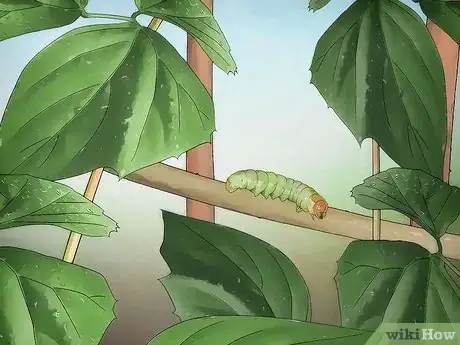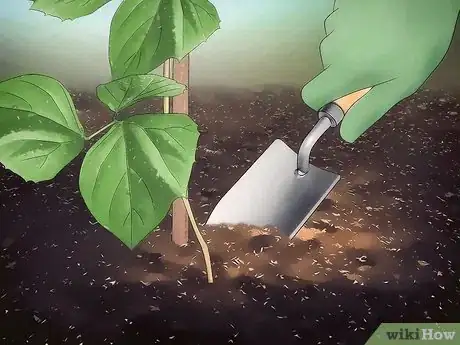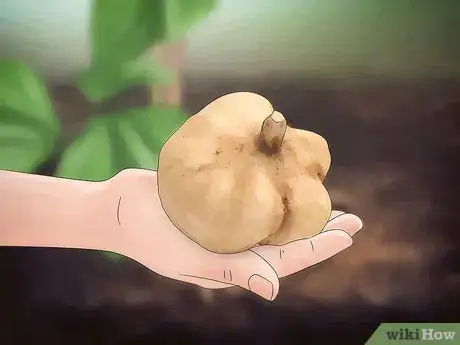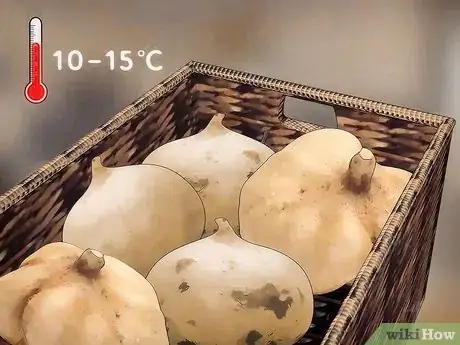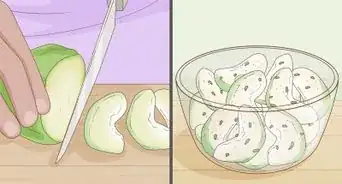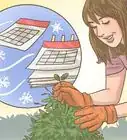This article was co-authored by Andrew Carberry, MPH. Andrew Carberry is a Food Systems Expert and the Senior Program Associate at the Wallace Centere at Winrock International in Little Rock, Arkansas. He has worked in food systems since 2008 and has experience working on farm-to-school projects, food safety programs, and working with local and state coalitions in Arkansas. He is a graduate of the College of William and Mary and holds a Masters degree in public health and nutrition from the University of Tennessee.
wikiHow marks an article as reader-approved once it receives enough positive feedback. In this case, 90% of readers who voted found the article helpful, earning it our reader-approved status.
This article has been viewed 95,841 times.
Jicama, or Pachyrhizus erosus, is a vine that is native to Mexico, although most people are familiar with its root, which is used in cooking. Jicama, also known as yam bean, can be found on tables in Mexican restaurants as a condiment, and it is widely used in recipes like fresh salads, salsas, and soups. Jicama requires a long growing season in order to produce the roots, or tubers, that provide the meat of the plant. Jicama is a tropical plant that grows best in warm climates throughout Central America and USDA zones 7 through 10. To grow jicama, plant the seeds, care for the plant, and finally, harvest the jicama.[1]
Steps
Planting Jicama Seeds
-
1Plant jicama after the danger of frost has passed. Jicama doesn’t do well during a frost, so wait to plant until the weather has warmed up to plant it in your garden. Research the average date of the last frost in your area, and plant your jicama one to two weeks after this date.
- The jicama plant may not grow properly if you live in an environment that stays mostly cold.
-
2Obtain jicama seeds. Unless you already have seeds, you will need to obtain them. Jicama seeds can be purchased at a nursery, some home improvement stores, or even online. Check the packet to make sure you have the right seeds before planting.Advertisement
-
3Soak the seeds. Put the jicama seeds in lukewarm water to speed up germination. Place seeds in a shallow pan of warm water. Allow them to sit for 24 hours. Then, remove the seeds from the water.[2]
-
4Choose a good location. Look for a place in your garden that receives at least 6 to 8 hours of sunlight per day. The spot you choose to grow the jicama will affect the outcome of the harvest. The location you choose should be exposed to full sun for the duration of the six to eight hours.[3]
-
5Make sure the location has good soil. Choose a location with moist but well-drained soil. Make sure the soil is alkaline with a pH over 7. You can test this easily with a commercial pH tester.[4]
- If you want to grow the seeds before the last frost, then you can plant them in a pot indoors. You should use planting soil, perlite, or vermiculite, and a little peat moss in a medium-sized pot.
- The pot should be placed under a grow light or by a sunny windowsill.
- If you start with the seeds in a pot, wait for them to grow to 3 in (7.6 cm) tall before you plant them in the garden.
-
6Water the seeds. If you decide to plant the seeds in a pot before the frost, you will need to take care of the seeds. Once you have planted them in a medium-sized pot with planting soil, water the seeds regularly until the last frost. Water the seeds until the soil is moist any time the soil feels dry.
-
7Dig small holes. Make the holes about 1/4 inch (0.6 cm) in depth. The amount of holes you dig depends on the number of seeds you have to plant. The holes should be about 12 inches (30.5 cm) apart. If you plant more than one row, then the rows should be 2 to 3 feet (0.61 to 0.91 m) apart.
-
8Place the jicama seeds in the soil. You can dig the holes first, or dig them as you plant the seeds. The soil should feel moist and warm without you watering it first. Cover the seeds and tamp them down lightly.
Caring for Jicama Plants
-
1Lightly water the planted jicama seeds. Sprinkle water over the soil after you plant and then when it becomes dry. Do not saturate the seeds with water, even if the soil is dry. The soil should only feel moist once you sprinkle the water.
- Using a watering can will help regulate how much water you pour onto the soil.
-
2Fertilize jicama once a month. You can use an all-purpose fertilizer. The exact instructions for fertilizing depends on the directions on the package of your fertilizer. Typically, you just need to apply the fertilizer around the base of the plant. You can purchase fertilizer at a nursery or at many home improvement stores.[5]
- Ask an employee at your nursery for fertilizer recommendations if you aren’t sure about which brand to buy.
-
3Stake the vines of the jicama plant. Jicama vines grow quite tall, so they will need support as they grow. Stake the vines when they are about 24 inches (61 cm) in length. Place wooden tomato stakes about 4 inches (10.2 cm) deep into the soil next to the jicama vine. Loosely tie each plant with twine.
-
4Check the jicama plants daily for dry soil. Don’t forget to keep the soil moist as the jicama grows. Test the soil out by feeling it with your hand or gently digging into it with your fingers. Only water when the soil is dry since jicama does not do well with over-watering.
-
5Deadhead the blooms. Remove the tiny flowers that bloom on the jicama. Removing the flowers encourages stronger root growth. You can remove them with your hand, scissors, or pruners.
-
6Don’t worry too much about pests. Jicama is not likely to have pest problems during growth. This is because the flowers, seeds, and leaves are poisonous. If you do find that you have a pest problem, remove the pests yourself, or use an organic pest spray.
- Make sure you know what type of pests you are targeting when you go to buy pest spray.
Harvesting the Jicama Tubers
-
1Dig the tubers from underground. Unearth the tubers from the ground using a trowel. Wait until late fall, but before the first frost to dig your tubers. This will be approximately 150 days from the time of planting. Unearth the tubers earlier than that if the vine shows signs of dying. Be careful to avoid injuring the tubers during removal. Take your time.[6]
- The tubers should be 3-6 inches (7.6-15.2 cm) in diameter.
-
2Collect the tubers. The tubers should be firm and round. Tubers that are soft and shriveled with visible cracks and/or bruising should probably be thrown out. Brush the soil off of the tubers.[7]
- Gently soak or wash them into water to remove clumps of mud or soil. Allow them to dry.<
-
3Store the tubers. Jicama plants will deteriorate if they are stored in a location below 50 degrees Fahrenheit (10 degrees Celsius). Ideally, store them in a location that is 53 to 60 degrees (11 to 15 degrees Celsius). This may be in a garage or heated basement. The location you choose should be dry. It should not be wet or humid. The jicama should be fresh and ready to eat for up to two months if stored properly.[8]
- You can store the jicama in bowls, racks, or pans.
Expert Q&A
-
QuestionWhen should you plant jicama in Florida?
 Andrew Carberry, MPHAndrew Carberry is a Food Systems Expert and the Senior Program Associate at the Wallace Centere at Winrock International in Little Rock, Arkansas. He has worked in food systems since 2008 and has experience working on farm-to-school projects, food safety programs, and working with local and state coalitions in Arkansas. He is a graduate of the College of William and Mary and holds a Masters degree in public health and nutrition from the University of Tennessee.
Andrew Carberry, MPHAndrew Carberry is a Food Systems Expert and the Senior Program Associate at the Wallace Centere at Winrock International in Little Rock, Arkansas. He has worked in food systems since 2008 and has experience working on farm-to-school projects, food safety programs, and working with local and state coalitions in Arkansas. He is a graduate of the College of William and Mary and holds a Masters degree in public health and nutrition from the University of Tennessee.
Food Systems Expert In most of Florida you should plant jicama in the early spring. If you are in south Florida, you could plant year round.
In most of Florida you should plant jicama in the early spring. If you are in south Florida, you could plant year round. -
QuestionHow many plants can you put in a 5 gallon container?
 Andrew Carberry, MPHAndrew Carberry is a Food Systems Expert and the Senior Program Associate at the Wallace Centere at Winrock International in Little Rock, Arkansas. He has worked in food systems since 2008 and has experience working on farm-to-school projects, food safety programs, and working with local and state coalitions in Arkansas. He is a graduate of the College of William and Mary and holds a Masters degree in public health and nutrition from the University of Tennessee.
Andrew Carberry, MPHAndrew Carberry is a Food Systems Expert and the Senior Program Associate at the Wallace Centere at Winrock International in Little Rock, Arkansas. He has worked in food systems since 2008 and has experience working on farm-to-school projects, food safety programs, and working with local and state coalitions in Arkansas. He is a graduate of the College of William and Mary and holds a Masters degree in public health and nutrition from the University of Tennessee.
Food Systems Expert You can grow one large Jicama plant in a 5 gallon container. I recommend spacing out the plants to encourage growth.
You can grow one large Jicama plant in a 5 gallon container. I recommend spacing out the plants to encourage growth. -
QuestionHow many fruits does a Jicama plant produce?
 Community AnswerIn my experience, one tennis ball sized tuber per plant, which makes it uneconomical unless you start many plants from seed. On the other hand, if you leave the tuber over several seasons, it will increase in size and can get as large as a small melon.
Community AnswerIn my experience, one tennis ball sized tuber per plant, which makes it uneconomical unless you start many plants from seed. On the other hand, if you leave the tuber over several seasons, it will increase in size and can get as large as a small melon.
Things You'll Need
- Jicama seeds
- Shallow dish
- Trowel
- Tomato stakes
- Twine
- All-purpose plant fertilizer
Warnings
- Do not store jicama in a very cold or hot location, or the tubers may die.⧼thumbs_response⧽
References
- ↑ http://www.nutrition-and-you.com/jicama.html
- ↑ https://bonnieplants.com/growing/growing-jicama/
- ↑ https://bonnieplants.com/growing/growing-jicama/
- ↑ https://bonnieplants.com/growing/growing-jicama/
- ↑ https://bonnieplants.com/growing/growing-jicama/
- ↑ https://bonnieplants.com/growing/growing-jicama/
- ↑ https://bonnieplants.com/growing/growing-jicama/
- ↑ https://bonnieplants.com/growing/growing-jicama/
- ↑ http://www.nutrition-and-you.com/jicama.html
About This Article
To grow jicama, purchase seeds from a home improvement store or online and soak them in warm water for 24 hours to speed up germination. Then, plant the seeds in a sunny part of your garden in holes at least 12 inches apart. After you’re done planting, sprinkle the area with water to moisten the soil. You should also fertilize the seeds once a month, and water them regularly to keep the soil moist. When the vines grow to about 24 inches, support them with stakes. Additionally, remove the flowers to encourage root growth. To find out how to harvest jicama tubers, read on!
